When you're seeking grip, performance, and durability, the right tires for your Kawasaki Ninja 300 can make all the difference. You'll want options that excel in various conditions, enhance stability, and suit your riding style. From the Dunlop Sportmax GPR-300's exceptional traction to the Michelin Scorcher 11's impressive handling, each tire brings unique advantages to your ride. However, not all tires are created equal, and understanding the nuances can elevate your motorcycle experience to new heights. What else should you consider to guarantee you choose the best fit for your needs?
Key Takeaways
- The Dunlop Sportmax GPR-300 series offers superior grip and performance in both wet and dry conditions, ideal for the Kawasaki Ninja 300.
- Michelin Scorcher 11 provides excellent dry road adhesion and effective water evacuation, enhancing rider confidence in varying weather.
- Bridgestone TW Series XL500S caters to dual sport enthusiasts, offering durability and performance across diverse terrains for off-road adventures.
- Proper tire size (110/70R-17 front, 140/70R-17 rear) is essential for optimizing handling, safety, and speed accuracy on the Ninja 300.
Dunlop Sportmax GPR-300 Radial Front Motorcycle Tire 110/70R-17
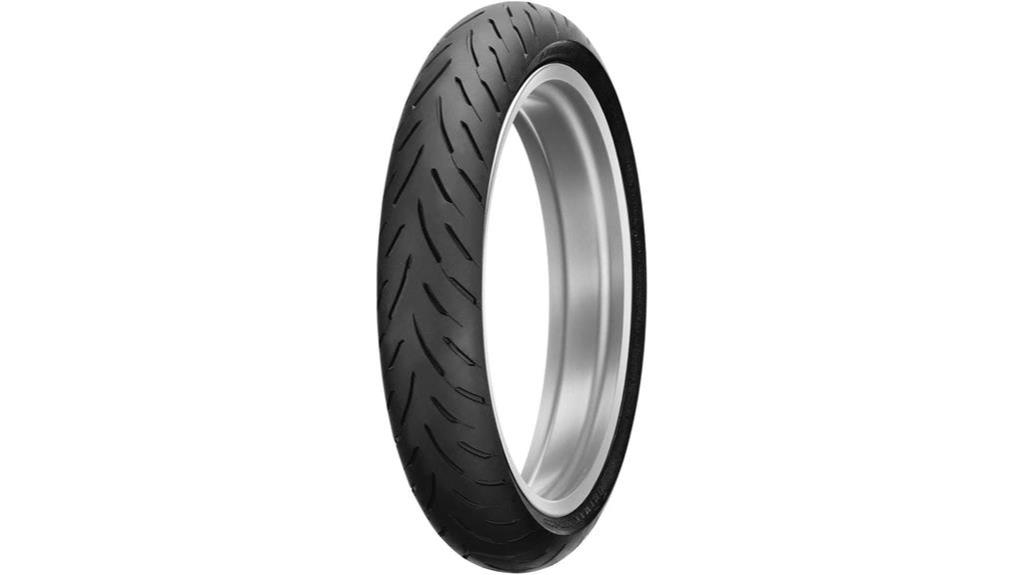
For riders of the Kawasaki Ninja 300 seeking superior grip and performance, the Dunlop Sportmax GPR-300 Radial Front Motorcycle Tire 110/70R-17 stands out as an excellent choice.
Designed specifically for small displacement sport bikes, this high-performance tire excels in both wet and dry conditions, ensuring riders maintain control regardless of the weather.
Weighing 22.5 pounds and featuring a 17-inch rim diameter, it fits a variety of models beyond the Ninja 300, including popular options from Honda, KTM, and Yamaha.
With a stellar customer rating of 5.0 out of 5 stars and a solid rank in street motorcycle touring tires, the GPR-300 proves to be a reliable option.
Its performance capabilities make it a top pick for enthusiasts looking to enhance their ride.
Best For: Riders of small displacement sport bikes seeking enhanced grip and performance in various weather conditions.
Pros:
- High-performance design provides exceptional grip in both wet and dry conditions.
- Wide compatibility with various models, including those from Kawasaki, Honda, and KTM.
Cons:
- Limited to small displacement sport bikes, may not be suitable for larger motorcycles.
- Weight of 22.5 pounds might be heavier compared to some competitors.
Dunlop Sportmax GPR-300 Sport Rear Motorcycle Tire – 180/55ZR17
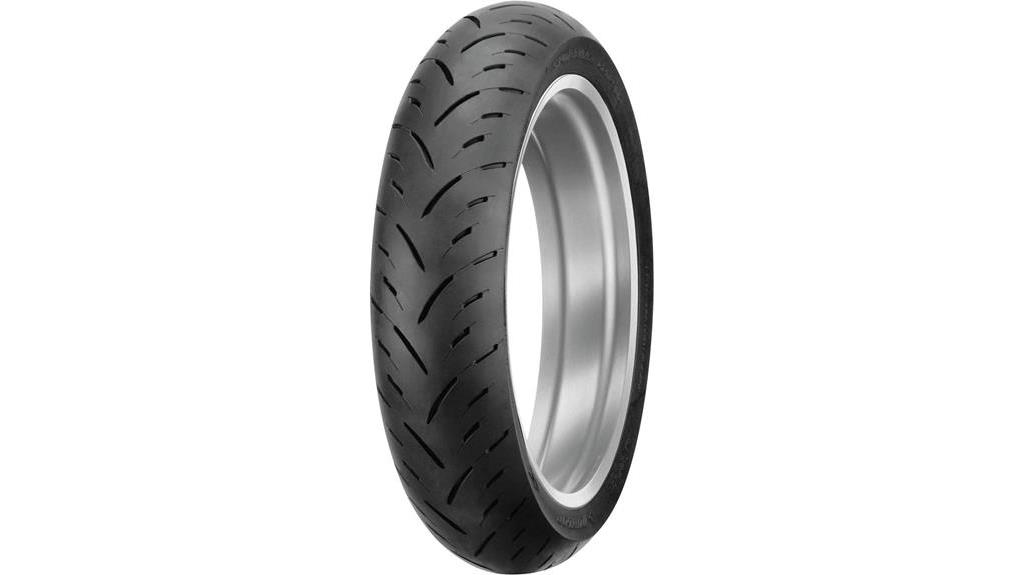
Offering excellent traction and handling, the Dunlop Sportmax GPR-300 Sport Rear Motorcycle Tire is an ideal choice for Kawasaki Ninja 300 riders seeking enhanced performance on the road.
This 180/55ZR17 tire boasts a load capacity of 805 pounds and a tread depth of 8/32nds, ensuring durability and reliability.
Weighing only 6 pounds, it provides a lightweight option that doesn't compromise on strength.
Customers frequently praise its responsive and predictable performance, averaging a solid 4.5 out of 5 stars across 144 ratings.
Designed for year-round use, the GPR-300 fits perfectly with the Ninja 300, along with other models like the Honda CBR250/300 and Yamaha R3.
With positive shipping experiences, this tire offers both quality and value for riders.
Best For: The Dunlop Sportmax GPR-300 Sport Rear Motorcycle Tire is best for riders of sport motorcycles like the Kawasaki Ninja 300 who prioritize traction and handling.
Pros:
- Great traction and handling for enhanced performance.
- Lightweight design at only 6 pounds, ensuring agility without sacrificing strength.
Cons:
- May not suit all motorcycle models; compatibility is limited to specific brands.
- Installation costs can vary and may add to overall expense.
Dunlop Sportmax GPR-300 Sport Front Motorcycle Tire – 120/70ZR17
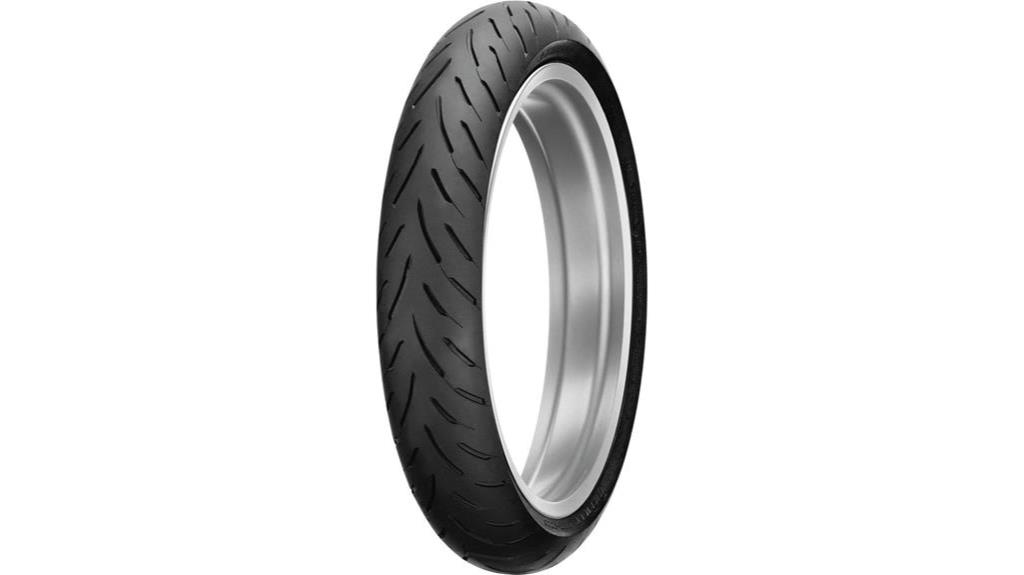
Riders seeking a balance of performance and value will find the Dunlop Sportmax GPR-300 Sport Front Motorcycle Tire – 120/70ZR17 an excellent choice for their Kawasaki Ninja 300.
This radial tire delivers impressive grip levels that inspire confidence in handling, often rivaling higher-priced competitors.
However, it's crucial to maintain proper tire pressure, around 34 psi rear and 35 psi front at 70°F, to optimize performance.
While the GPR-300 excels in dry conditions, caution is advised in wet weather, as users report decreased traction during trail-braking.
Compared favorably to Michelin options, many riders appreciate its mileage and overall satisfaction, making it a smart choice for those who prioritize quality without breaking the bank.
Best For: Riders looking for a high-performance tire that offers great value without compromising on quality.
Pros:
- Impressive grip levels that inspire confidence in handling, especially in dry conditions.
- Cost-effective option compared to competitors like Michelin Pilot Power 2CT and Michelin Road 5.
Cons:
- Caution needed in wet conditions, with reports of slipping during trail-braking.
- Tire performance is sensitive to pressure and temperature, requiring careful monitoring.
Dunlop 300R-05 Sportmax GPR-300 Sport Rear Motorcycle Tire – 190/50ZR17
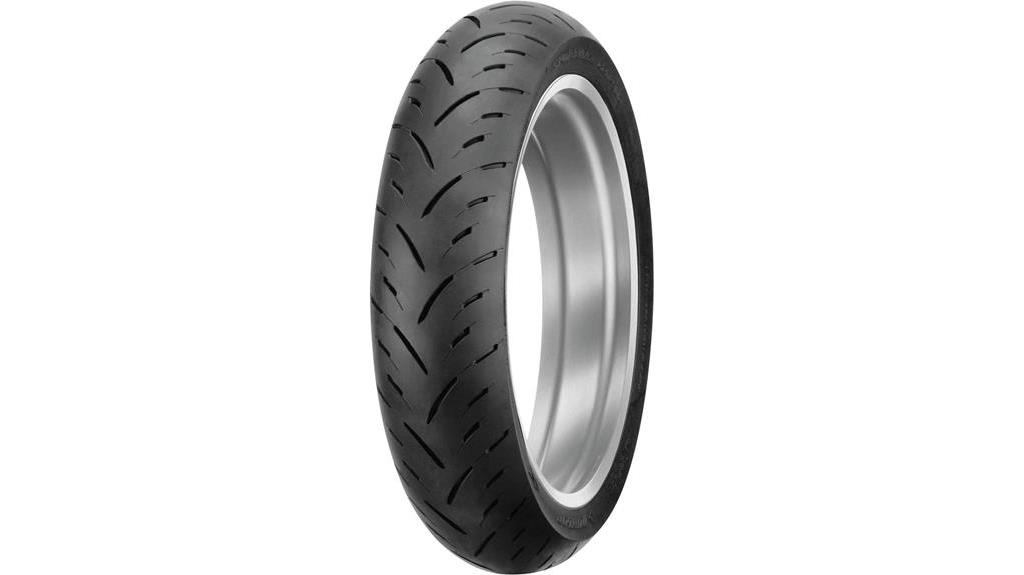
The Dunlop 300R-05 Sportmax GPR-300 tire is an exceptional choice for sport bike enthusiasts looking to enhance their Kawasaki Ninja 300's performance with its advanced grip in both wet and dry conditions.
Designed specifically for small displacement sport bikes, this 190/50ZR17 radial tire offers optimized construction that improves handling and responsiveness.
Its aggressive tread pattern not only boosts performance but also enhances the bike's overall appearance.
The advanced Jointless Band (JLB) design guarantees smooth performance and consistent tire contact, providing better stability.
With an average rating of 4.4 out of 5 stars, customers appreciate its quality and performance, making it a reliable option for riders seeking an upgrade.
Best For: Sport bike enthusiasts looking for enhanced grip and performance on their small displacement motorcycles.
Pros:
- Improved handling and responsiveness due to optimized construction.
- Aggressive tread pattern enhances both performance and the bike's appearance.
Cons:
- Limited fitment primarily for specific models, such as Honda CBR250/300 and Kawasaki Ninja 300.
- May wear out quicker than touring tires due to its performance-oriented design.
Michelin Scorcher 11 Rear Motorcycle Tire 150/70ZR-17
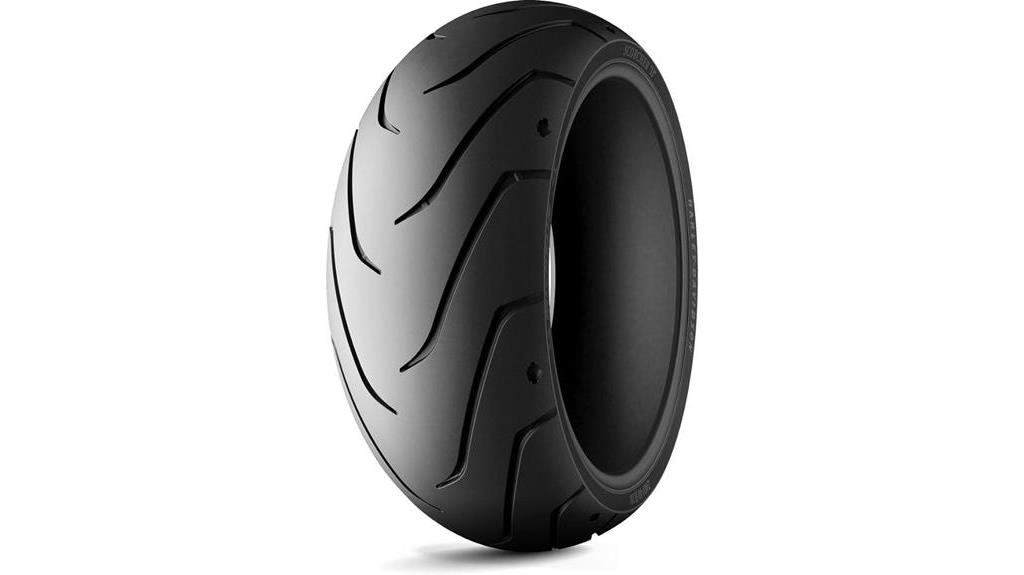
Designed for performance and durability, the Michelin Scorcher 11 Rear Motorcycle Tire 150/70ZR-17 is an excellent choice for Kawasaki Ninja 300 owners seeking enhanced grip and handling on both dry and wet roads.
This tire features a semi-slick tread pattern that provides outstanding dry road adhesion, while its optimized tread groove design guarantees effective water evacuation for reliable wet grip.
Weighing only 5.2 pounds, it boasts a load capacity of 716 pounds, making it suitable for various motorcycle models, including select Harley-Davidson and Honda bikes.
With positive customer feedback highlighting impressive tread life and mileage, the Scorcher 11 stands out as a solid factory replacement.
Riders can trust Michelin's latest radial technology for precise handling and performance on every ride.
Best For: Riders of Kawasaki Ninja 300 and other compatible motorcycles looking for enhanced grip and performance on both dry and wet roads.
Pros:
- Excellent tread life and durability from championship-winning race tire technology.
- Outstanding grip with a semi-slick tread pattern, ensuring superior dry road adhesion.
Cons:
- Customer ratings indicate mixed feedback, with an average score of 3.9 out of 5 stars.
- Limited compatibility with certain motorcycle models may restrict options for some riders.
Bridgestone TW Series XL500S Honda Front Tire – 300-23 – 300-23
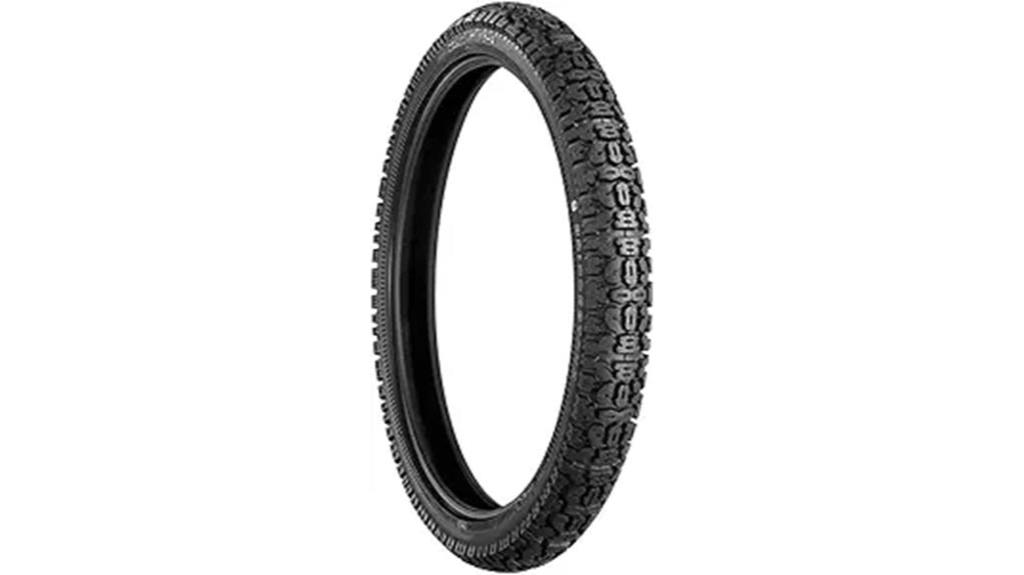
Engineered for dual sport enthusiasts, the Bridgestone TW Series XL500S Honda Front Tire offers a unique front/rear combination that enhances both highway and off-road performance on the Kawasaki Ninja 300.
This 4-ply tire features a special dimpled tread pattern designed for maximum traction, ensuring a confident ride across various terrains.
Its self-cleaning tread blocks improve grip in muddy and loose conditions, making it ideal for adventurous riders.
Weighing just 7.63 pounds and with a knobby tread type, it's built for year-round use.
With a stellar 5.0 out of 5 customer rating, it's evident this tire is a favorite among users.
Plus, it comes with a 30-day return guarantee, offering peace of mind for buyers.
Best For: Dual sport riders seeking a tire that excels in both highway and off-road conditions.
Pros:
- Excellent traction due to the special dimpled tread pattern, enhancing performance on various terrains.
- Self-cleaning tread blocks that maintain grip in muddy and loose conditions.
Cons:
- Limited availability may affect purchasing options for some customers.
- Best suited for dual sport use, which may not cater to riders focused solely on street or off-road applications.
ITP Mud Lite AT Tire 24×8-11 – Fits: Honda TRX 300FW 4X4 1988-2000
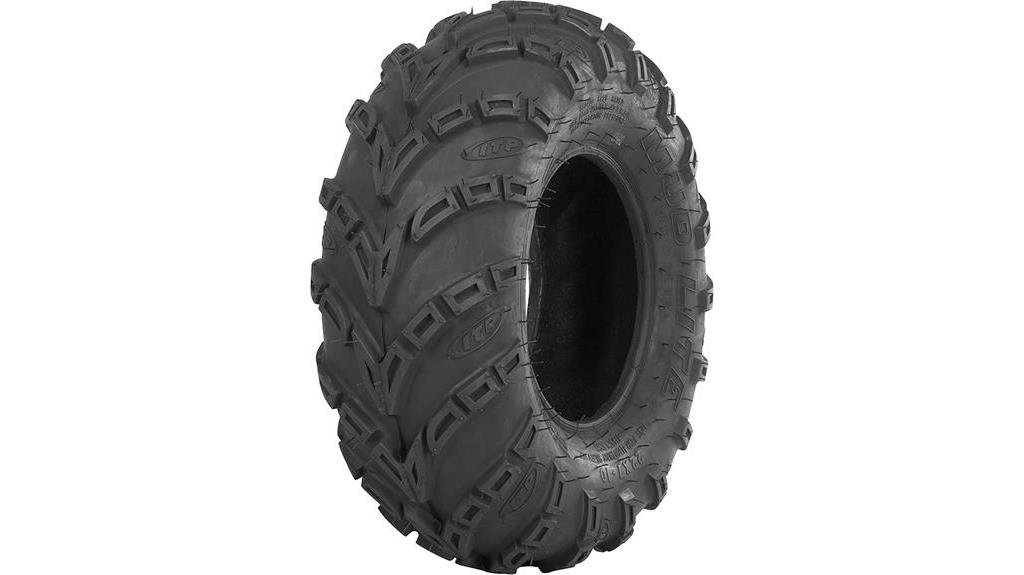
For riders seeking reliable performance in mud and snow, the ITP Mud Lite AT Tire 24×8-11 stands out as a top choice for the Honda TRX 300FW 4X4 from 1988 to 2000.
This tire features a 6-ply construction, ensuring durability, while its non-directional tread design provides excellent traction on various terrains.
Weighing just 14.04 pounds, it offers a lightweight option that enhances handling.
The unique center tread guarantees a smooth ride, complemented by angled shoulder lugs for superior grip in muddy and snowy conditions.
With an average rating of 4.7 out of 5 stars, users appreciate its performance and value, especially when compared to OEM tires.
Overall, it's a dependable option for adventurous riders.
Best For: Riders of the Honda TRX 300FW 4X4 (1988-2000) seeking reliable performance in mud and snow conditions.
Pros:
- Excellent traction in mud, dirt, and snow, enhancing overall performance.
- Lightweight design improves handling and maneuverability on various terrains.
Cons:
- Some users report sizing discrepancies upon receipt of the tire.
- Traction may not be optimal in deep snow conditions.
Factors to Consider When Choosing Tires for Kawasaki Ninja 300
When choosing tires for your Kawasaki Ninja 300, you should consider several key factors that can affect performance.
Think about the tire type, the impact of weather conditions, and the importance of grip and traction.
Additionally, make certain the size is compatible and the tread pattern suits your riding style.
Tire Type Selection
Choosing the right tire type for your Kawasaki Ninja 300 is vital to match your riding style and enhance performance on the road. First, consider whether you prefer sport, touring, or dual-purpose tires. Each type affects handling and performance differently, so select one that aligns with how you ride.
Radial tires are ideal for sport bikes, as they provide better grip and stability at high speeds. This is important for maximizing the Ninja 300's sporty characteristics. When evaluating options, look for tires with enhanced wet and dry grip capabilities to boost your confidence and control.
The tread pattern also plays a significant role in traction. A semi-slick or aggressive tread design can greatly improve cornering performance and grip on both asphalt and wet surfaces.
Be certain to check that the tire sizes—like 110/70R-17 for the front and 140/70R-17 for the rear—are compatible with your bike. Having the right sizes guarantees you maintain proper handling dynamics and performance standards, ultimately elevating your riding experience on the Ninja 300.
Weather Conditions Impact
Weather can greatly affect your riding experience on the Kawasaki Ninja 300, so selecting tires that perform well in various conditions is vital. When choosing tires, you need to prioritize their grip in both wet and dry conditions to guarantee safe handling. Wet weather can considerably impact traction, especially when trail-braking on slick surfaces. Some tires may struggle here, so be mindful of their performance characteristics.
Maintaining the recommended tire pressure is essential, especially as temperatures fluctuate. Proper pressure guarantees maximum grip and handling during varying weather conditions. Additionally, consider the tread pattern; optimized grooves can enhance water evacuation, improving wet grip and reducing the risk of hydroplaning.
Keep in mind that tire performance can also vary with temperature changes. As seasons shift, you might need to adjust your tire choices or pressures to maintain ideal handling characteristics.
Grip and Traction
Grip and traction are fundamental for your Kawasaki Ninja 300's performance and safety, especially in varying road conditions. When choosing tires, focus on those with an aggressive tread pattern and advanced rubber compounds. These features enhance grip, allowing for better cornering and braking performance, which is essential for a thrilling ride.
Maintaining ideal tire pressure is another key factor. Under-inflated tires reduce contact with the road surface, leading to compromised traction. Always check your tire pressure regularly to guarantee you're getting the most out of your tires.
Also, consider tread depth when selecting tires. A deeper tread can channel water away from the contact patch, which is crucial for maintaining traction on wet roads. This is especially important if you frequently ride in rainy conditions.
Lastly, be aware of how temperature changes can affect tire grip. Tires often perform differently in colder conditions, so think about seasonal variations when making your choice.
Size Compatibility Importance
Selecting the right tire size for your Kawasaki Ninja 300 is crucial for achieving ideal handling and safety on the road. The recommended sizes are 110/70R-17 for the front and 140/70R-17 for the rear. Using the correct tire size guarantees that your motorcycle performs as intended, providing optimal stability and responsiveness in various riding conditions.
When you choose tires that fit the manufacturer's specifications, you're enhancing your cornering capabilities and traction. Incorrect sizes can compromise weight distribution, affecting braking performance and overall control. Plus, improper sizing can lead to discrepancies in your speedometer readings, making it difficult to gauge your speed accurately.
It's also important to reflect on how tire size influences your Ninja 300's gearing. An incorrect tire size could alter your ride's dynamics, impacting acceleration and top speed. Consequently, sticking to the specified tire sizes isn't just a suggestion—it's crucial for your safety and riding experience.
Tread Pattern Design
When it comes to choosing tires for your Kawasaki Ninja 300, the tread pattern design plays a vital role in determining your bike's overall performance and handling. An effective tread pattern greatly impacts grip and traction, especially in varying weather conditions. If you ride in both wet and dry environments, consider a tire with a design that enhances performance in both scenarios.
Aggressive tread patterns often provide better grip during cornering and braking, which is critical for sport bikes like yours. These patterns are engineered to improve water evacuation, reducing the risk of hydroplaning and guaranteeing stability on wet surfaces.
Moreover, the shape and depth of tread grooves affect the contact patch with the road, influencing how responsive and stable your ride feels. Different tread patterns can also alter wear characteristics, impacting durability and overall performance over time.
Consequently, it's important to choose a tread pattern that aligns with your riding style, whether it's sporty, touring, or commuting. By considering these factors, you'll enhance your riding experience and make certain your Ninja 300 performs at its best.
Performance Features Evaluated
Evaluating the performance features of tires for your Kawasaki Ninja 300 is critical to secure ideal handling, stability, and safety on any ride. Start by looking for high-performance radial tires that provide enhanced grip in both wet and dry conditions. This guarantees you maintain control, regardless of the weather.
Next, consider tires with a consistent tire contact patch. This feature improves stability and responsiveness during cornering and acceleration, allowing you to enjoy a smoother ride. Additionally, select tires that incorporate advanced belt designs, such as Jointless Band (JLB). These designs contribute to smoother performance and reduced vibration, enhancing your overall riding experience.
Don't forget to evaluate the tread patterns. Effective water evacuation and wet grip are essential for minimizing slipping in rainy conditions.
Finally, always pay attention to recommended tire pressures. Maintaining proper inflation is imperative for maximizing grip and overall performance, so check your tire pressure regularly.
Price Vs. Quality
Balancing price and quality is essential for choosing tires that enhance your Kawasaki Ninja 300's performance and safety. When you're shopping for tires, consider that higher-priced options typically offer better grip, handling, and longevity. The materials and technology used in premium tires contribute to improved performance, which can greatly enhance your riding experience.
While lower-priced tires might seem appealing at first, they often wear out faster and deliver subpar performance. This can lead to more frequent replacements, ultimately costing you more over time. Investing in high-quality tires means better traction and stability in various conditions, reducing your risk of accidents.
User reviews can also guide your decision. They often show that budget tires may perform adequately but generally fall short in reliability and safety compared to reputable brands. By weighing the cost against the benefits of quality tires, you'll find that spending a bit more upfront can give you better performance and safety on the road.
Installation Considerations
Choosing the right tires for your Kawasaki Ninja 300 involves several important installation considerations to guarantee peak performance and safety.
First, make certain the tire size matches the manufacturer's specifications, typically 110/70R-17 for the front and 140/70R-17 for the rear. This guarantees proper fitment and handling.
Next, check the load capacity of the tires, which should support around 805 pounds for sport tires, including the motorcycle and rider. This is essential for safe riding, especially during high-speed maneuvers.
Consider the installation process as well; it may require specific tools and expertise. Many riders prefer professional installation to make sure the tires are fitted and balanced correctly, which can notably affect performance.
Don't forget to verify the recommended tire pressure settings, usually around 34 psi for the rear and 35 psi for the front. Maintaining these pressures helps maximize performance and safety.
Lastly, review the tread pattern and composition of the tires, as these factors greatly influence traction and handling in various weather conditions.
Frequently Asked Questions
How Often Should I Replace My Ninja 300 Tires?
You should replace your Ninja 300 tires every 5,000 to 10,000 miles, depending on your riding style and road conditions.
Regularly checking the tire tread and looking for signs of wear can help you determine when it's time for a change.
If you notice decreased traction or uneven wear, it's probably time to invest in new tires.
Keeping an eye on your tires will guarantee a safer and smoother ride.
Can I Mix Different Tire Brands on My Ninja 300?
Mixing different tire brands on your Ninja 300 is like playing with fire; it can lead to unpredictable results.
While it might be tempting to grab whatever's available, it's best to stick with matched pairs.
Different brands can have varying grip levels and handling characteristics, which could compromise your ride's stability and safety.
If you want a smooth, thrilling journey, consider using the same brand and model for both tires.
What Tire Pressure Is Recommended for the Ninja 300?
For your Ninja 300, the recommended tire pressure is typically around 36 psi for the front and 42 psi for the rear.
These values can vary based on your riding style and load, so it's smart to check your owner's manual for specifics.
Keeping your tires properly inflated improves handling, fuel efficiency, and safety.
Remember to check the pressure when the tires are cold for the most accurate reading.
Are There Tires Specifically Designed for Wet Conditions?
Ever tried riding on slick roads during a downpour? It can be nerve-wracking!
Yes, there are tires specifically designed for wet conditions. These tires feature deeper treads and specialized compounds that enhance grip and reduce hydroplaning risk.
When you choose tires like these, you'll feel more confident maneuvering through rain-soaked streets.
Look for options that highlight their wet-weather performance to guarantee you stay safe and in control when the skies open up.
How Do I Properly Maintain My Motorcycle Tires?
To properly maintain your motorcycle tires, start by checking the tire pressure regularly.
Keep it at the manufacturer's recommended level for peak performance.
Inspect the tread for wear and replace tires when they're worn down.
Clean your tires to remove debris and guarantee better grip.
Rotate them periodically for even wear, and store your motorcycle in a cool, dry place to prevent damage.
Conclusion
Choosing the right tires for your Kawasaki Ninja 300 is like finding the perfect dance partner; they can elevate your ride to exhilarating heights.
With options like the Dunlop Sportmax GPR-300 and Michelin Scorcher 11, you'll grip the road with confidence, whether you're carving through corners or cruising on the highway.
Don't just settle for any tire—invest in the ones that match your style and release the full potential of your ride.
Your adventure awaits!